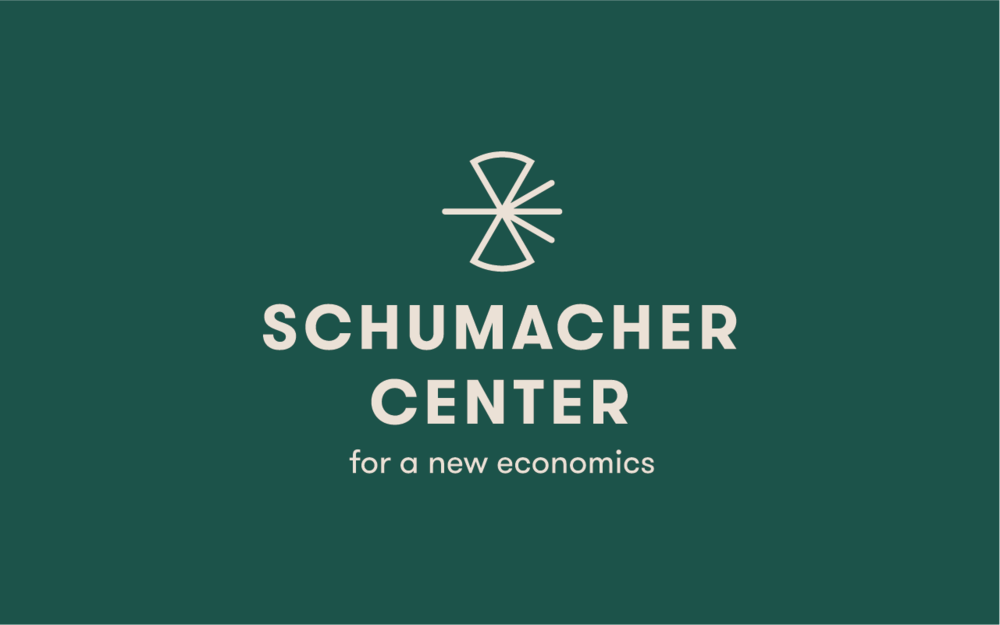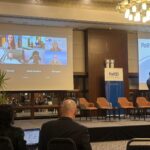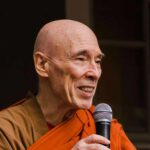
Introduction by John McClaughry
CHAIRMAN, BOARD OF DIRECTORS, SCHUMACHER CENTER FOR A NEW ECONOMICS
In the seventeen-year history of Schumacher Lectures, we have on several occasions had a speaker from the biological sciences, but to the best of my recollection we’ve never had a physical scientist. For someone who started out as a physicist this is a special privilege for me to be able to present to you Arthur Zajonc, Professor of Physics at Amherst College. Arthur has been a visiting professor and a research physicist at École Supérieure in Paris, the Max Planck Institute for Quantum Optics, and the Universities of Rochester, Innsbruck (Austria), and Hannover (Germany). He is a nationally and internationally known expert on quantum optics and, beyond his professional expertise, a well-known commentator and social thinker concerned with such subjects as mind and consciousness as they relate to the physical world and vice versa; the history of science; and Goethe, the German thinker, poet, and great literary figure. He is the author of Catching the Light: The Entwined Histories of Light and Mind, co-author of The Quantum Challenge, and co-editor of Goethe’s Way of Science. The former program director of the Fetzer Institute in Kalamazoo, Michigan, which tries to combine science, consciousness, and spirituality, he is currently President of the Anthroposophical Society in America and of the Lindesfarne Association. We welcome him not only as a scientist but also as an historian and social critic and a person of compelling insights into our world and its future: Dr. Arthur Zajonc.

First let me express what a great pleasure it is to be here with such a distinguished group, not only of speakers but also of participants. In addition it is a privilege to be one in the long line of speakers who have been part of this series over the past seventeen years. The ideals of E. F. Schumacher live in the hearts of all of us here and, I think, of a great many others throughout the world.
I would like to start by holding our collective feet to the fire and dramatizing the particular modern problematic in which we find ourselves. The history of Western civilization John Mohawk gave us earlier this morning—a history of domination of both the environment and indigenous peoples—is the history of ourselves and remains the history in which we still find ourselves embedded. That is to say, we still participate fully, all of us, speakers included, in that troubling history.
We are meeting at Williams College. I teach at Amherst College. Both are places of enormous privilege. Here in the Clark Art Institute we are surrounded by the fruits of European high culture as well as the finest works of American art. All of us, having arrived here on the backs of our automobiles, are part of a privileged elite. For large portions of the earth’s population America is felt as being on their backs. It is only because they are impoverished, because their rain forests are being destroyed, because their mineral resources are being extracted and exported that we are able to get to lectures like this, tape-record them, and finally publish them on paper produced from their trees.
The pattern of exploration and development continues. One of the great questions we must ask as modern, conscious, somewhat self-reflective individuals is, What can we do about the burden imposed on the earth by our actions? Is it possible to alleviate it, mitigate it, live through it? And what is the role of technology relative to it? If we are responsible for such a burden, can’t we find a way to relieve it, perhaps by returning to a manner of living like that of several thousand years ago or even a few hundred years ago—one that has, for example, a much closer relationship to the land?
The urban populations of the world are increasing significantly. In 1960, in the least developed nations of the world, only 9 % of the population lived in urban centers; now it’s 26 %. In industrial nations like our own, 75% of our population are located in urban centers. And the growth of the urban population continues: we’re approaching a time when 50% of the world’s population will live in cities and urban areas. Notice that the greatest growth, from 9% to over 25%, is occurring in those places of the world which have traditionally been the most rural. In other words, there is a flight of indigenous people—out of the bush, out of their traditional homelands—into cities in the hope of bettering their lives economically.
I once had a conversation about this topic with Wes Jackson of The Land Institute. We were in Mattfield Green in the former school building he purchased as part of his project to reconceptualize the rural farmlands of America. The small towns and communities that once flourished there are vanishing, and Wes has felt strongly that there must be a way of reestablishing them.
I said, Wes, we’re talking about resettling America; what fraction of the population do you think it is possible to have living on the land? He replied, Well, Art, I’ve done that calculation, and it’s 30-35%. And I said, But 75% of the American people live in cities (not just the large cities but also counting the smaller ones); that means there’s room for only an additional 5-10% on the land. If we believe Wes’s calculation, and I have no reason not to, then only 5 or 10% of the urban population can move back onto the land before the impact starts to damage that environment significantly. In other words, we’re in a box.
The problematic is not an academic one that is somehow going to disappear, even if we were to stabilize the population on the planet at its present level of 5 billion people, which probably all of us recognize as very unlikely. Over the next decades the burden of population and consumption is likely to increase. The American situation will become the world situation. Take a look at Europe: Holland already has 90% of its people in urban centers; England no longer has the forests it did even a few hundred years ago. What in the world are we going to do? What is the role technology has played in this development, and what is the future role of technology?

Dr. Arthur Zajonc
To address the question of technology and our future we can start with E. F. Schumacher’s famous lecture “Buddhist Economics” (later reproduced in Small is Beautiful), which he gave to the Teilhard Society, founded in memory of Teilhard de Chardin, the great Catholic scientist and thinker. The lecture took as its starting point the concept of Right Livelihood, one of the eight features of the noble path presented by Gotama Buddha. Schumacher reasons that if there can be a Right Livelihood, then there must be a kind of right economics, a Buddhist economics, which underpins that Right Livelihood. I would pose by extension the question, “If there is a Buddhist economics, is there a kind of Buddhist or right technology, a right way of working, of being in the world actively, which is also part of that economic process in which we find ourselves embedded?” We can ask this question whether or not we are Buddhists or spiritually minded in any way.
What is our image and understanding of technology? And connected with this is the question of our image and understanding of work itself, that is to say, the relationship between what we do and the instruments we use to do it.
Consider for a moment various attitudes toward work. One attitude is that work is penance; it’s basically a kind of punishment for being alive. This view dates back to the origins of Western civilization. In Genesis we find Adam and Eve expelled from the Garden of Eden, a place of abundance where everything they needed was provided to them. Because they chose to eat of the fruit of the Tree of Knowledge—that is, to gain self-awareness—God speaks these words to Adam:
Because you have listened to your wife
and have eaten from the tree which I forbade you
accursed shall be the ground on your account.
With labour you shall win your food from it
all the days of your life. . . .
You shall gain your bread by the sweat
of your brow until you return to the ground.
In other words, the plight of the human being is to labor by the sweat of our brows. Labor is penance for having dared to know, for having dared to disobey. This is certainly one view that continues to this day: the grind, the hardship of toiling in order to survive. Yet it is only one view of work, one I will not discuss further here. Rather, I would like to hold up another and more positive understanding of the nature of work, one which existed parallel with the early Western religious imagination of work as penance: namely, work as something high and noble. Often in the Christian West it was understood in analogy to the Creation of the world by God himself, who “worked” for six days to fashion a world, to fashion a universe. By working, according to this view, human beings are imitating their Creator. We too are creators, and like Him we should end each day’s work by standing back and judging whether what we have done is good or not.
Schumacher, in his lecture on Buddhist economics, also takes a high and positive view of human work. I’d like to quote a couple of short passages from that lecture:
The Buddhist point of view takes the function of work to be at least threefold: to give a man a chance to utilise and develop his faculties; to enable him to overcome his ego-centeredness by joining with other people in a common task; and to bring forth the goods and services needed for a becoming existence.
How wonderful: to develop one’s capacities, to join with other people in a communal task, and to provide for existence.
Again, the consequences that flow from this view are endless: to organise work in such a manner that it becomes meaningless, boring, stultifying, or nerve-racking for the worker would be little short of criminal; it would indicate a greater concern with goods than with people, an evil lack of compassion and a soul-destroying degree of attachment to the most primitive side of this wordly existence.
He goes on to say, “A Buddhist sees the essence of civilisation not in a multiplication of wants but in the purification of human character. Character, at the same time, is formed primarily by a man’s work.”
This is a very different and uplifting understanding of the nature of work: through it we educate ourselves morally as well as, one might say, skillfully. What we do shapes who we are as well as produces the goods and services needed for life. If we do something that is demeaning, stultifying, soul-crushing, nerve-racking, boring—then what we do gradually works its way inside us and debilitates and demoralizes us, diminishing our full capacity. If, on the other hand, we can find a way of working by fashioning convivial tools, as Ivan Illich might have called them, with which to work, then work can be ennobling, it can be nourishing, and the full capacity of our own humanity can unfold through that nourishment.
I want to emphasize another feature of what work can potentially be, one which I believe is too often ignored. It is illustrated by a story, a Taoist tale with the title “The Woodcarver,” from a little book called The Way of Chuang Tzu. Listen for what it means to work as did the ancient Taoist woodcarver:
Khing, the master carver, made a bell stand
Of precious wood. When it was finished,
All who saw it were astounded. They said it must be
The work of spirits.
The Prince of Lu said to the master carver:
‘What is your secret?’Khing replied: ‘I am only a workman:
I have no secret. There is only this:
When I began to think about the work you commanded,
I guarded my spirit, did not expend it
On trifles that were not to the point.
I fasted in order to set
My heart at rest.
After three days fasting, I had forgotten gain and success.
After five days
I had forgotten praise or criticism.
After seven days
I had forgotten my body
With all its limbs.By this time all thought of your Highness
And of the court had faded away.
All that might distract me from the work
Had vanished.
I was collected in the single thought
Of the bell stand.‘Then I went to the forest
To see the trees in their own natural state.
When the right tree appeared before my eyes,
The bell stand also appeared in it, clearly, beyond doubt.
All I had to do was to put forth my hand
And begin.If I had not met this particular tree
There would have been
No bell stand at all.What happened?
My own collected thought
Encountered the hidden potential in the wood;
From this live encounter came the work
Which you ascribe to the spirits.’
It’s a beautiful story of what it could mean to be a craftsman, a woodcarver; a tale which reveals the outer craft, which has always been recognized, but joined with it is something of equal and I would say even greater importance for our own situation, namely, what one could call the interior as opposed to the exterior dimension of work. The interior dimension includes the cultivation of the single thought of the bell stand, the quietness of soul, the lack of hubris, the distance from praise, criticism, and the glories of the court—all that would distract from the pure thought of the bell stand. In other words, craft is for the Taoist woodcarver a spiritual practice as much as an external occupation. To carve the wood, to beat the iron into its form—these are as much interior as exterior acts.
This high view of work and the relationship between the inner and the outer is not something one finds only in the Buddhist tradition through E. F. Schumacher or in the Taoist tradition; one finds glimmers of it in our own Western tradition as well. For example, Meister Eckhart in speaking about outer work also joins it to inner work when he says: “The outward work can never be small if the inward one is great, and the outward work can never be great or good if the inward is small or of little worth. The inward work always includes in itself all size, all breadth and all length.”
To draw a quick conclusion in answer to our initial fundamental question: All merely external solutions which we hope will somehow rectify the world situation by a purely external, material fix will ultimately fail. They will be eroded from within. There has to be, I believe, some kind of renewed marriage or joining between the inner and the outer dimensions of work, and I think this is arguable not only on its own merits but also on the basis of these long traditions. This is something Schumacher pointed to at the end of his Guide for the Perplexed: that the transformation, the renewal of society will initially take place from within and not from without.
The idea that work has a high and even sacred dimension you find also during the time of its worst violations—for example, during the Industrial Revolution. In some ways that vast demeaning assault on what work could be, brought to the fore articulate spokesmen in its defense. To pick just one little refrain from Thomas Carlyle’s Labour:”All true Work is sacred; in all true Work, were it but true hand-labour, there is something of divineness. Labour, wide as the Earth, has its summit in Heaven.” Thus, together with the view of work as penance we have the view of work as something elevated, with inexhaustible positive and sacred dimensions. But this is not the view that has prevailed.
One must remember that the notion of a literate and highly educated society whose members attend institutions of higher learning is a relatively recent development. Earlier, the human being was educated through work. If education took place, especially outside the monasteries, it took place really only through guild systems, through apprenticeship as farmer or craftsman, that is to say, through the body. We educated ourselves through our actions. What became of those actions in the seventeenth, eighteenth, nineteenth centuries?
For me, the story which stands out as emblematic is the one of Eli Whitney meeting with the newly elected President of the United States, Thomas Jefferson, and John Adams, the second President, in the equivalent of the Oval Office. Whitney brings ten muskets with him, and he does something which to us seems trivial: he takes them all apart and scrambles the parts on the table. At random he takes a part from one musket and attaches it to another until he has reassembled ten muskets from the scattered parts that were on the table. Jefferson, who had a primarily agrarian vision of America as a country of yeomen farmers, realized the potential of what he was seeing: he had just witnessed a demonstration of the invention of interchangeable parts, and he granted Whitney an extended military contract to manufacture muskets.
Until that time, everything that was made was made uniquely. You couldn’t go to the hardware store and buy a 6-32 machine screw. You couldn’t buy a replacement part for anything. You had to go to the craftsman, to the smith, and he would make a new part, uniquely suited to the purpose at hand. By 1800 a new era in our relationship to the material world, to craft, to the work which had always been part of both our outer and our inner lives, was beginning.
The new trend was accelerated by two other developments: first, the beginnings of the assembly line, where the tasks themselves were broken down into smaller and smaller parts, and second, scientific management. Through Frederick Winslow Taylor’s writings, time-study analysis enters upon the scene, and the human being is harnessed to the assembly line to become part of the machine. It is at this point that work becomes a mindless, stultifying, boring, and demeaning enterprise for a great many people caught in the factories, a phenomenon all too well known to us. If we look at Studs Terkel’s book Work, we find a wonderful opening interview with Mike Lefevre, a steelworker from Indiana. Mike is characterizing his own life:
I’m a dying breed. A laborer. Strictly muscle work . . . pick it up, put it down, pick it up, put it down. We handle between forty and fifty thousand pounds of steel a day. (Laughs.) . .
A mule, an old mule, that’s the way I feel. Oh, yeah. See. (Shows black and blue marks on arms and legs, burns.) You know what I heard from more than one guy at work? ‘If my kid wants to work in a factory, I am going to kick the hell out of him.” I want my kid to be an effete snob. Yeah, mm-hmmm. (Laughs.) I want him to be able to quote Walt Whitman, to be proud of it.
If you can’t improve yourself, you improve your posterity. Otherwise life isn’t worth nothing. You might as well go back to the cave and stay there. I’m sure the first caveman who went over the hill to see what was on the other side—I don’t think he went there wholly out of curiosity. He went there because he wanted to get his son out of the cave. Just the same way I want to send my kid to college.
You’re doing this manual labor and you know that technology can do it. (Laughs.) Let’s face it, a machine can do the work of a man, otherwise they wouldn’t have space probes. Why can we send a rocket ship that’s unmanned and yet send a man in a steel mill to do a mule’s work?
Automation? Depends how it’s applied. It frightens me if it puts me out on the street. It doesn’t frighten me if it shortens my work week. You read that little thing: what are you going to do when this computer replaces you? Blow up computers. (Laughs.) Really. Blow up computers. I’ll be goddamned if a computer is gonna eat before I do! I want milk for my kids and beer for me. Machines can either liberate man or enslave ‘im, because they’re pretty neutral. It’s man who has the bias to put the thing one place or another.
An extraordinary statement by the steelworker Lefevre.
In the words of Lefevre, which we could also find in Dickens and Steinbeck, in any number of authors, we see the transition from a traditional society connected to the land, connected to human hands, connected to work in a manner which seemed to educate, to ennoble, to shape character in ways we and Schumacher would commend. All that is replaced by what William Blake would call “the satanic mills,” wheels within wheels in our factories. The German poet Rainer Maria Rilke would write in a similar vein:
All we have gained the machine threatens, as long
as it dares to exist in the mind and not in obedience.
Nowhere does it stay behind; we cannot escape it at last
as it rules, self-guided, self-oiled, from its silent factory.
It thinks it is life: thinks it does everything best,
though with equal determination it can create or destroy.
What I have presented is, to a certain extent, the standard account of technology and the development of the Industrial Revolution, an account which speaks in a romantic and enthusiastic way about the simple and marvelous past, a past that praises the craftsman, and demonizes the present industrial means of manufacturing. There is enormous truth in this view, not a grain of which I would take away, yet this interpretation aggravates our modern dilemma instead of helping to solve it. Therefore, I would like to complicate the story somewhat by running back through it. We should realize that technology itself, the largeness of technology, especially in America, its grandeur—and I recommend David Nye’s book The American Technological Sublime on this subject—have also been part of a transcendental, even spiritual, vision which we have celebrated.
When Dickens, who was no friend of the steel mills or the textile mills of England, visited Lowell, Massachusetts, the very first place where such factories were built in this country, he was amazed. These were huge structures, a mile or so along the riverfront, total institutions with social and health benefits provided by the factory owner. At the end of his visit he said, “I solemnly declare that from all the crowd I saw I cannot recall one young face, mostly female, that gave me a painful expression.” And he said, “I would not have taken any one of them from their job because it seemed they were so happy and delighted to be doing their work.”
Ralph Waldo Emerson was so impressed by the workers that he would go and lecture to them. When Andrew Jackson visited Lowell, he was so struck by the sight of the eight thousand young women factory workers, perfectly and primly dressed in white, who lined the streets to greet him, that he demanded to have the mills, which had been closed to celebrate his arrival in Lowell, put back in operation so that he could marvel at their method of production. They were a vision for him of what America could become. What Jefferson had been shown by Eli Whitney and welcomed in the end into America, Jackson also celebrated in Lowell. He did not know that the average tenure in those factories was nine months. Conditions were so appalling from the standpoint of health and safety that as soon as they could, the women of those factories quit.
Another instance of the sacred or sublime aspect of technology becomes evident at the great Philadelphia Exposition of 1876. You need to imagine at the very center of that Exposition a coupled pair of steam engines, two pistons roughly the size of this room powering the generators or the dynamos that would provide the electricity for the entire Exposition. These two Corliss steam engines became the icon of the national celebration of the hundredth anniversary of the American Dream. The opening of the Exposition took place with enormous fanfare, and that same Walt Whitman whom Mike Lefevre wishes his son could quote came in his rolling chair and requested that he be set in front of the great Corliss steam engine. There he is supposed to have sat for over half an hour and pondered silently the nature of this machine.
In the famous chapter “The Dynamo and the Virgin” in The Education of Henry Adams, an autobiography written in the third person, Adams compares the power of the dynamo with the power of the Virgin in France—Notre Dame, Our Lady, who was able to so effuse French culture that cathedrals to her sprang up all over France and indeed Europe. He writes that in America, in place of the Virgin we have the Dynamo, the great generator of electricity. To Adams, the dynamo became a symbol of infinity. . . . he began to feel the forty-foot dynamos [at the Great Exposition of 1900] as a moral force, much as the early Christians felt the Cross.
The dynamo as a moral force—what a wonderful conjoining of opposites; this great device, this great machine, is felt as a moral presence in the landscape. Adams brings the dynamo into connection with the Cross, which is of course one of the instruments of Christ’s suffering. Thus, he sees the dynamo as an instrument of our suffering, but by the same token it must also be understood as an instrument for redemption. Did he have the full ambiguous scope of that symbol in mind?
I am reminded here of Heidegger when he refers to the question of technology and quotes the poet Hölderlin, who said, “But where the danger is, grows the saving power also.”
Where the danger is, grows the saving power also. In other words, it is part of the modern dilemma we find ourselves in that we must find the courage to stand at the forge where the danger is. We must stand at the edge of the technological abyss and yet find the presence of mind and the moral capacity to deal with the realities that surround us constantly day to day and year to year.
The notion of technology as bringing progress and fulfillment, yet also imbued with powers that demean and deprive and stultify, reveals its ambiguous nature. Something which is felt to be awe-inspiring, even transcendent in its capacity to lift us up to a new moral imagination is at the same time threatening; that which can ennoble and educate us can also destroy our planet. There are those who believe that this deep ambiguity inherent in technology is a feature only of modern technology, and yet I can assure you that is not the case. Technology has always shown this double-edged sword.
Consider the story of Cain and Abel. Cain, whose name in some etymologies means “smith,” slays his brother. Yet it is Cain who is the keeper, the individual whose blood line will give rise to the crafts. He and his kind are the ones who will transform the earth. But his line is marked; that is to say, he is an outcast. Interestingly enough, you find this same marking, this same segregation of the craftsman, in many traditional cultures. The Mande blacksmiths, for example, form a particular caste; they live at the edge of the town in which they work. Members of an African tribe, as smiths they are essential to agriculture, to medical knowledge, to initiation practices, to the arts, and so forth. In addition they are woodcarvers. They are crucial to the successful unfolding of the culture of the Mande, and yet they are a caste unto themselves. No one outside of that caste can marry into it, for that person’s body would then explode. No one else has the capacity to handle the energy, the life force, residing in the members of that caste or clan.
Recall also the Greek myth of Hephaestus. He is the only one of the gods who is a reject. Do you remember his story? He is born from Hera. When Zeus looks at him, he is so displeased at the sight that he pitches him off Mount Olympus. Hephaestus falls all day long until he lands on the volcanic island of Lemnos. Depending upon the version, either he is lamed there or he was already lame when Zeus saw him. In either case, he is always depicted as the laughing stock of the gods, the god who limps along, swarthy and dirty. Nonetheless, Hephaestus is the only one of the gods, for all their powers, who can make things in this world. He makes the aegis, Zeus’s shield; he fashions Pandora; he forges the chains that will bind Prometheus to the Caucasus Mountains. Every other god is powerless in this regard; only the broken god, the marked god, the outcast, is able to craft anything.
I think all of us bear Cain’s mark; we have all been thrown from the heights, we have all been expelled from the Garden. We are all the sons and daughters of Cain to a certain extent. That is part of our human condition, not the modern dilemma but simply the dilemma of being incarnate in a body at all. Our body is the first techné, the first vehicle, the first instrument.
Have we mastered it? We master the forge, the anvil, the hammer; we master our Microsoft Windows 95 program, that most of all. Each of these extends us into the world, into our own body, into our modern—you could even say alienated—environment. And again, remember that the union of the inner and the outer, the charge of the sacred, was very much a part of the ancient imagination of technology. Technology was ambiguous with regard to the craftsmen and their particular role in society, but it was always morally charged and was held within the large spiritual imagination which all ancient peoples had of their universe.
As an example of the sacred significance granted to technical operations by virtue of context, we can consider mining. What did it mean for the ancient miner to go into the earth and extract ore? When I was touring America with my sons several years ago, we went into the great mines—gold mines, coal mines; it took a lot of arranging, but eventually we got into some of them. We also went to the LTV/Republic steel mills in Ohio. It’s an extraordinary landscape, the American industrial landscape, one that’s basically off limits because of safety and insurance concerns, but if you can get in, you’re confronted with the “technological sublime” I described earlier, simply by virtue of its scale, its enormity. Yet it is a purely secular and material environment.
Whether it was the Mande blacksmith or somebody from another of the great cultures engaged in the extraction and refining of ores, before he went into the earth as an ancient metallurgist, he performed a set of rituals after first determining the auspicious day for the mining operation. The men who were the miners would segregate themselves from the rest of society for several days. They would perform ritual purifications, fasting and abstaining from sexual activity. That is, they would go through a practice that made them ready to enter into the mother—for the earth was considered to be the mother matrix of all existence.
The miners went into the mother intending to do something that was highly magical. They were going to perform a kind of obstetrical operation. They were going to remove what in the Egyptian language were called the kubu. When Egyptologists first saw this word kubu, they wondered what it signified that kubu were brought to fiery furnaces to be refined and smelted. Kubu means embryo. Miners went into the earth and delivered embryos prematurely, then placed them in a furnace. According to their understanding, metals were ripening inside mother earth the way a child ripens in the womb of a human mother.
Thus, the task of the metallurgist in ancient times was to enter the earth-mother and remove the embryo “out of time,” as Mircea Eliade says in his book The Forge and the Crucible. Then the smith would bring the ore-embryo to a premature ripening so that the metals themselves could be produced and then worked. Mining and refining were, therefore, sacred operations and sacred occasions, requiring all manner of attendant rituals and ceremonies. Every action of the technologist was embedded in a magical world, where entering the mine was experienced in a context that gave it many levels of meaning. Metallurgy became a morally charged technique, deeply laden with significance, meaningful for the craftsman but also meaningful for his whole community.
The story of industrialization, then, is in some ways the story of the loss of this interior or sacred dimension, the loss of an alliance between inner and outer. And so my concern about the future of technology really revolves as much around the question of consciousness as around the question of external technique.
I really do believe that any technology we may invent, no matter how innocent it appears, can—depending on who applies it and on the moral universe into which it is placed—be used to serve us well or ill. There is no way we can completely safeguard technology, but then, there is no way we can live in our bodies in a manner that is without danger, either.
In the ancient world a sense of responsibility, of a moral context, was provided by the traditions and culture in which people grew up and learned their trade. It was provided also by nature, which was always around them. The situation we presently live in is very different. We will never resettle our full population into a natural landscape. Just imagine taking the wilderness areas we presently have and running our full population through them on a frequent basis. It would destroy them. I think the notion that nature will somehow provide a moral context for us in the same way it did for the ancients is simply not tenable.
We must therefore find other sources. We must have the confidence that there will always be, no matter how difficult it is to establish, a basis for right conduct, for Right Livelihood, for a right technology. But it will not happen automatically. It will not happen simply because we have a bright idea that can make some money. A deep ambivalence exists within technology as it has evolved from the crafts all the way through the Industrial Revolution to the current Information Age, as it is sometimes called, which is the result of an evolution which has increasingly estranged technology from our own hands. It has gradually become an autonomous technology, one that is separated from us, that rests on an ethics which seems to be alienated from our personal ethics.
Somehow the economic system, the manufacturing system, has taken charge. The whole situation is reminiscent of the story of the sorcerer’s apprentice. We have mastered both matter and power and have recently learned how to join them to a kind of externalized intelligence. More precisely stated, through modern technology we can couple seemingly boundless energy sources to computers, which act as a cybernetic or disembodied intelligence that runs technology on its own.
We have created thereby a realm of existence which can either become entirely daemonic or—if penetrated with our own highest moral intelligence—be constituted in ways which would serve a right livelihood. And this, I think, we have to do in freedom, because in a certain sense we have lost the traditions. I may speak out of these traditions, but they do not live in most people. We have lost them; we have also lost naive access to the moral force found in nature. Our hours are spent in front of television sets, in cars, and in houses; they are not spent in the forests tracking animals. Thus, we must find another means by which we can connect ourselves to the source of appropriateness and scale—of “rightness”—in relationship to our institutions, to nature, and to one another. Only then will the future of work be truly beneficial and uplifting, truly ennobling, because the technologies we develop will be technologies which serve rather than destroy.
Here one might sense me beginning to devise a perfect postmodern landscape verging toward a utopian climax. But this is not called for. Rather, I believe one finds already existing within contemporary life the beginnings of a future scenario which can serve us well. In other words, there is a possibility for a positive future to arrive, not via some abstract fantasy but organically out of the longings and imaginations and realities of our lives.
I’d like to give a few indications of what I mean by this. Some of these new directions the Schumacher Center for a New Economics and many of you in this audience and your friends and neighbors—and people like you living on other parts of the planet—can probably take some credit for. They are modest developments, many of them only partial ones, but they are heading in the right direction. These are examples of the techné, the means by which we can go from where we are to where we need to be. Techné in ancient Greek does not mean technology in our sense, it means art. It means craft in the sense of the arts, and there’s no distinction between the fine arts and the manual arts. They were all of a piece. I think we can find the art that will allow us to create a life which is far better and perhaps even sustainable and harmonious.
Think of the question of scale, which was so much on Schumacher’s mind. We can be responsible only for that which we can comprehend; if something gets too big, it becomes abstract and distant from us; it becomes impossible. That is why we now have such endeavors as micro-lending, micro-enterprises, micro-credit of the kind provided by the Grameen Bank in Bangladesh and neighboring regions. An article in The Wall Street Journala couple of days ago quoted the Aspen Institute’s estimate that there are 328 micro-lending institutions and micro-enterprises in the United State, and that is probably an underestimate. It is an interesting phenomenon in and of itself that The Wall Street Journal even reported on micro-lending—on a $10,000 loan given to a man to buy a truck in order to make it possible for him to support his family.
Consider also the prospect of micro-enterprise or short-run production and the possibility that the assumptions of economies of scale, which have always driven manufacturing to larger and larger dimensions, are beginning to be called into question. Will it ultimately become more sensible to produce short runs of goods which are designed for specific uses, specific individuals, specific communities, as opposed to one size fits all? Imagine a situation where every individual says, I don’t want what everybody else has; I want what I want. I want it to fitme, to be my size, the color I like; I want to have this design and not the design that happens to be on the shelf—in which case you couldn’t make a department store big enough to hold all those items of clothing. The means of manufacturing would have to become individualized instead. I believe that such realities are around the corner.
My description is reminiscent of the blacksmith who made one nail at a time, each different from the one before. In other words, if we can get back in touch with one another to discover what we want, what we need, then we must develop a means of manufacturing based on those distinct and individual needs. This can happen only if production is broken down to a much smaller and more responsive scale. Big factories will become colossal white elephants. A way will be found to restore the lightness, the responsivity, the kind of variety that can exist in small community-based manufacturing enterprises, which, moreover, are not capital intensive. It will not require a billion dollars to set up the micro-manufacturing plant. We already have the means to distribute some of these products: Federal Express and United Parcel Service are examples of ways of connecting to one another that didn’t exist until recently.
Commentators such as Peter Drucker, who is no left-wing radical, keep talking about “postcapitalist” society. They speak of the so-called third sector, the nonprofit volunteer part of society, as the largest financial sector in America. Drucker says, for example, that if you take the number of people employed in volunteer work—mostly part time—it’s the equivalent of seven and a half million work years annually. Seven and a half million people fully employed every year. Together they would earn $150 billion if you were to pay them. Of course, they are not being paid, but this is an economic force we should not underestimate.
Maximo Kalaw, the current President of the Earth Council and the man who ran the summit of nongovernmental organizations or NGOs at the 1992 Rio Earth Summit, gave a paper in San Francisco on the occasion of the fiftieth anniversary of the United Nations. He spoke about governments no longer providing for the guarantee of civil society or the rights of individuals. Increasingly, these are being addressed and secured by NGOs and nonprofits. Imagine a world in which governments are paralyzed. Those who do govern will in a certain sense be exactly the invisible organizations that currently do not even show up on the economic map. Something is bubbling, as it were, under the surface.
I do not know what will drive the changes required. Perhaps the sheer scale of current institutions will prove to be too colossal; perhaps they will begin to fragment, and companies will begin to divide up, with small companies emerging which can respond quickly to the needs and wants and interests of local communities and even communities across larger distances. I think there will be all kinds of mixes. Nonprofit groups will often take on some of the tasks of nation-states and governments.
If you read Jeremy Rifkin, who talks about the future of work, you begin to realize that perhaps there will come a time when work itself will simply not be available. We will have to provide for meaningful work in totally new ways. Frithjof Bergmann, a philosopher at the University of Michigan, has for the past twenty or so years been coming up with some remarkable ideas in the area of the future of work. Indeed, some features of the landscape of the future, it seems to me, are already starting to emerge. Technology will certainly always be there, as part of that landscape. The question is how technology will be organized in relation to work.
Let me end with a final image that I find compelling. We first educated our bodies through our growing mastery of technology. The smith at his forge is the archetype for this—Hephaestus, the great Greek craftsman who provided an example of learning through the body. But in more modern times, education has become liberated from the body, you might say, and is instead connected to the head, to the intellect, so that we now educate ourselves and our children by means of a new and more abstract form of education conducted in special public and private institutions of learning that are set apart from life. It is a disembodied form of education, and we worry about that.
I believe that the educative force of nature, which had always been around us, has also been displaced. The moral or, if you will, spiritual force of nature has become more distant and abstract; it went out into the stars, to the periphery, disappeared into the cosmos. That which had been present in tradition, society, culture, and nature became less and less a constraint or guiding reality. It disappeared into the universe. We have in a certain sense become liberated and free; we have become autonomous individuals in ways that separate us from the constraints of civilization and nature, but as a result we are endangering our human world and our planet.
Something is missing in the picture of body and mind that I have presented, something that is indicated in the story of Hephaestus through the woman to whom he is married—Aphrodite, the most beautiful of all the Greek goddesses. We should picture Hephaestus as swarthy, bearded, leather-aproned, and lame. Yet he is married to beauty; he is married, you might say, to what could ultimately become love.
Where is this element in our story? Where is beauty? Where is art? Where is love? If they cannot find their way back to the center in a manner that is fitting for our future, then I don’t think there is any hope for technology. The wisdom of the Greeks is that they put beauty, art, and love together with technology. They did not put Aphrodite with Mars, with whom she has flings once in a while. They did not put her with one of the other beautiful gods; they placed her with us, who are lame, who are of this earth, and yet on whom so much depends.
If we can find our way to that place of the heart—not just body and mind but heart—then it is my conviction that from out of the cosmos, into which all of the inner dimensions of our world disappeared, there will return wisdom, the wisdom which is joined to the heart, not as cold knowledge, not as the fruit of the Tree of Knowledge, but as the fruit of the heart. This heavenly wisdom has been known throughout all times as Isis-Sophia, who will once again join hands with human beings in order to create a fertile future. The marriage of love with techné can produce the offspring for which we all long, an art of living as free moral beings in both the human and nonhuman worlds. To me, this is synonymous with Right Livelihood.
Excerpts from the Question & Answer Period
(Questions were inaudible; only the answers follow.)
For many years I have been a student of Rudolf Steiner’s writings. Steiner, who was trained as a scientist, engineer, and philosopher, considered his own task to be very much that of combining a modern scientific world with an essentially Western esoteric Christian understanding of the human being and of world history. His work is related to the modern dilemma we have spoken about here. I have found much in his writings to be enormously helpful and informative on this subject.
The conjoining of the worlds of the sacred and spiritual with the most contemporary and secular dimensions of our everyday lives is, I think, a difficult task we have to work at consciously. Kirkpatrick Sale, in introducing John Mohawk earlier today, talked about coming belatedly to a similar kind of conclusion. I am convinced that we need to find a nonsectarian way which allows people to be entirely free to connect these two worlds—the inner and outer, the exoteric and esoteric.
In the past ten years I’ve had a chance to travel extensively and spend time with many groups, including secular circles committed to social action as well as indigenous cultures and scientific communities, and so on. And I can tell you that the landscape is changing. It’s easier to bring this matter up now. You can bring it up in contexts that are quite surprising, especially if it’s done with a certain detachment, which I think is healthy. You simply say, Let’s entertain this as a possibility; here is a resource we may need, and we have not tapped it before, namely, an inner resource.

I helped to organize a conference with Frithjof Bergmann. We brought together twenty-five or so people to address the question of the future of work. Let me tell you some of what we talked about.
It looks as though the current trend will continue, and increasingly—through automation and a number of other innovations—fewer and fewer people will be required to provide for the standard of living we have today (it may also be that the standard of living will change). The decline in “jobs” will happen over approximately the next thirty to sixty years. What this will mean ultimately is that something on the order of a third of the population will be needed to do “the work” as it’s presently done today. If that is the case, then what is going to happen to the other two-thirds? We are all in this, not just the factory workers but everyone.
At the conference we discussed possible ways of restructuring work in three particular areas:
One is the actual work, let’s say in the factory. Is it possible to make it more humane? The answer is certainly yes. There are factories, especially in Scandinavia, which have tried to take steps in this direction through different ways of organizing the work, different ways of moving people through the factory, the use of teams to build an entire car as opposed to one person working on only one feature. You actually have all the parts flowing to one station, and a small crew makes the cars. They cost a little more to construct per car, but basically a small cadre of people makes an entire vehicle.
There are other innovations that can be introduced, such as continuous learning organizations, with managers and workers coming together periodically in order to educate themselves and assess their personal growth. Such efforts demonstrate ways in which the factory can care for the continuing unfoldment and development of its employees.
We also talked about ownership issues. Should ownership be held off the premises by stockholders or by pension funds or whoever it is who has all the capital, or should it be otherwise? That’s an enormous issue. Are there ways of organizing major manufacturing and service elements of our society entirely around alternative ownership forms like nonprofits? There are no stakeholders in the traditional sense in nonprofits. How would you capitalize industry in such a case? Are there new kinds of financial institutions that will need to arise?
The second area we explored was high-tech homesteading. Many of us provide for ourselves: that is to say, we grow our gardens, we improve our homes, we improve a whole variety of things. We take care of ourselves, and there’s an economic value to that. Could high-tech self-providing be developed in ways to further enliven our communities and our personal lives? As opposed to farming everything out to others to do, can more of us bring things back toward ourselves by a kind of contemporary homesteading?
The third area we addressed is what we called “paid vocations.” Frithjof Bergmann had a Center for New Work in Flint for many years, and he would sit down and talk with unemployed auto workers. He would ask, What is it you would like to do with your time now that you are unemployed? The first response was likely to be, I want to go fishing. A rather unthinking response. Sure, it’s nice to go fishing, but you’re not going to fish all the time.
Then Bergmann would say, No, what do you really, really want to do? And quietly there came the response, I’d like to teach history.—Why would you like to do that? — Well, I’ve always loved history, American history. — So Bergmann realized that beneath the veneer of the working-class man or woman was a learned person, a compassionate individual who had always been blocked from connecting to his or her calling or vocation. Is there a way that we can free that potential and connect individuals to their callings?
These restructurings will take place incrementally. At first an enlightened leadership can begin by setting up alternatives, by piloting them, showing their feasibility. Then, as the job situation gets bad, people will have something to turn to instead of despair.
Here is another illustration of how I think change will tend to come about: go to the worst place, go to the inner city, where unemployment is already at 30%, 40%, even 50% in some places. Imagine this as the future! This isn’t a bad section of town; this is the future. And then say, Let’s see what we can do here, because this is the future. You can just move across town and you are moving forward in time. Then you set things up and you get things to work there—or not. Of course, people are always looking for fixes for those sorts of places, so you can get a little funding for it, because nobody else wants to be there. So you go and improve the situation. Then, when things worsen and people ask, What in the world can we do? you have a program piloted out; you’ve created in the present the institutions which will actually be the institutions of the future—in places where the future is already in the present. Gradually those institutions will grow to become part of the larger landscape.
The classic example of this for me is the situation in the former Soviet Union when Gorbachev was saying, Let’s have a parliament. I remember thinking to myself, This is a joke! There’s still the KGB, the Politburo, and the army. That is where the power is, and he wants a parliament? A lot of folks are going to get elected, and they’re going to argue among themselves and debate among themselves and pass meaningless laws. It’s just a great big joke.—But then what happened? Everything collapsed around them. It was as if they barely got themselves up and running, and everything collapsed. Just imagine if that parliament, that joke, had not existed. You would have had the former Yugoslavia but on a vast scale; you would have had genocide. But the very fact that some kind of alternative democratic vehicle existed gave democracy at least a breath of a chance.
It seems to me that very often we’re in a similar situation. We’re putting up parliaments or other institutions, which from one standpoint look to be a joke. Yet they end up as the best bet for a viable future. I helped start a community-supported agriculture project; I helped start alternative medicine; I’ve helped start a lot of alternative things, just the way all of you have, and we have to admit that they look like a joke. Someone in big business, one of the Fortune 500s, will say, Oh, there are a few hundred community-supported agriculture farms; that’s nice. Together they make as much grain as one of my farms.—”My” farms out in Iowa, and he’s in New York. Still, my guess is that if we’re going to have a future, it’s going to be organized around ways of manufacturing, of farming, of educating that will be totally surprising. And we’ll have the last laugh on that joke.
Closing Remarks from the Speakers’ Panel with John Mohawk and Greg Watson
Both of my counterparts spoke about what we might call some of the most difficult and pressing needs of our time: on the one hand, the history not only of our technological abuse of our natural surroundings but also of our abuse of one another through violent acts. My sense, much like John’s, is that it’s important to have this history very much in view. It’s only by attending to those difficult and challenging parts of our individual lives and of our society and of industry and the economy that we have any hope of perceiving the potential for the emergence from apparently diverse elements of ways to create something we really had no reason to expect to arise, like John’s example of water from hydrogen and oxygen. It’s an act of faith to believe that if you go into the difficulty, into the danger, into the impossible even, somehow you’ll emerge whole and maybe even emerge better.
I think the description of the Dudley Street Neighborhood Initiative is a case in point. I hadn’t heard about the Initiative before, and I’m very grateful to have learned about it here from Greg Watson because it’s the kind of thing I think will become increasingly exemplary. It’s an extraordinary story that depicts how human beings can take a completely devastated landscape—abused, polluted, trashed, hazardous—and how, through a kind of fidelity to one another, through changing their own lives in community process by means of what Greg called civic alchemy, they can begin to grow a solution, at least something that moves them from where they were into a much better situation. No panacea, no silver bullet, not something that can be replicated without a great deal of forethought but nonetheless the fruit of a kind of confidence in human beings.
I’ve heard of similar things going on in Vancouver and in Detroit, where urban disasters have in their own unique ways been visited on those communities. In all three instances, what one is doing is asking, What ails thee? It’s the Parsifal question in the great tradition of the medieval romance. It means going into the inner cities and asking, What ails us? What ails our communities? And then finding the medicine that will make whole. It’s a matter of being willing to feel the pain of the other, and it’s only through that act of compassionate knowing that one can help the healing to come about.
I also want to comment about something you said, John, that struck me. Having grown up within and participating in an indigenous culture, for many years you felt that the solution would lie in a return to nature or to a kind of environmental or natural ethic, but later in your life you lost that feeling or modified it in some way. You didn’t really go into much detail about that. I grew up by and large not having a connection to nature yet feeling that there must be a source to which one can go—in the absence of everything there must still be a source. Take the example of the Tibetan monk or nun who has been imprisoned in a Chinese prison, or Rigoberta Menchu, who grew up under horrific circumstances. Yet within their life stories one finds the possibility of moral action, of forgiveness, of reconciliation, of a new life, a new beginning. It wasn’t necessary for them to sow the seeds of hatred in the wake of that kind of abuse. Where does that strength come from? What is its source? If we can find it in ourselves and find it in one another and build on that, it seems to me that there are grounds for hope.
I must say that although I am optimistic in the large sense of options that Greg talked about, I am not very optimistic concerning the near term. I think that it’s probably going to get worse before it gets better, that the future he’s working in is likely to be a larger and larger part of our future, and we’ll need to find ever more dynamic sorts of responses. At the same time I have enormous confidence and exhilaration concerning human capacities. I believe there is light at the center of our interior darkness. On that basis I feel optimistic.

Source: https://centerforneweconomics.org/publications/buddhist-technology-bringing-a-new-consciousness-to-our-technological-future/











